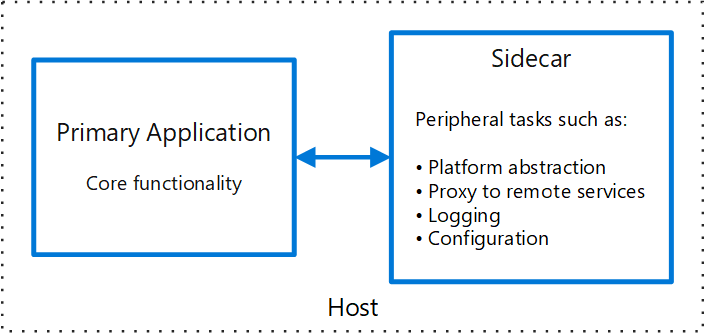Side car pattern and it's use case in Software Design
The sidecar pattern is a design pattern used in software architecture where an auxiliary process or container (the "sidecar") runs alongside a main application process or service.
This sidecar typically handles secondary or cross-cutting concerns like logging, monitoring, service discovery, or configuration management, without interfering with the main application's logic.
Key Features of the Sidecar Pattern
Isolation: The sidecar runs independently of the main application but shares the same environment (e.g., a container or a virtual machine).
Transparency: It provides services to the main application without requiring changes to the application's core code.
Scalability: Sidecars scale alongside the main application, ensuring consistent behavior for each instance.
Language Agnostic: The sidecar can be implemented in any language or framework, independent of the main application.
How the Sidecar Pattern Works
Main Application: The primary service that performs the core business logic.
Sidecar: A separate process or container that handles auxiliary tasks such as:
Proxying traffic
Collecting metrics
Configuring service discovery
Encrypting/decrypting data
Communication:
The main application and sidecar typically communicate via inter-process communication (IPC), shared volumes, or network interfaces.
Common Use Cases for the Sidecar Pattern
1. Service Mesh
Description: In a service mesh architecture, each service instance includes a sidecar proxy (e.g., Envoy or Linkerd) for managing network traffic.
Use Case: Traffic routing, load balancing, and mutual TLS for secure communication between services.
Example: Istio uses the sidecar pattern to inject Envoy proxies into Kubernetes pods for managing inter-service communication.
2. Monitoring and Logging
Description: A sidecar can collect logs or metrics from the main application and forward them to a central logging or monitoring system (e.g., Elasticsearch or Prometheus).
Use Case: Centralized log aggregation without modifying the main application.
Example: Fluentd or Logstash runs as a sidecar to ship logs from an application container.
3. Configuration Management
Description: The sidecar retrieves configuration settings from a central system and applies them to the main application dynamically.
Use Case: Dynamic reloading of configurations without restarting the main application.
Example: A configuration sidecar syncs updates from a system like Consul or ETCD.
4. Security and Authentication
Description: A sidecar handles authentication and encryption for the main application.
Use Case: Offloading encryption (e.g., SSL/TLS termination) to a sidecar.
Example: A service that offloads JWT validation to a sidecar for token verification.
5. API Gateway/Proxy
Description: A sidecar acts as an API gateway or reverse proxy for the main application.
Use Case: Caching, request routing, or rate limiting.
Example: NGINX or HAProxy running as a sidecar proxy for an application.
Benefits of the Sidecar Pattern
Decoupling: Auxiliary tasks are abstracted away from the main application logic.
Reusability: Sidecars can be reused across multiple applications with minimal changes.
Simplified Maintenance: Changes to sidecar functionality do not require redeploying the main application.
Scalability: Sidecars scale with the main application, ensuring consistency in behavior.
Flexibility: Supports polyglot services by being language-agnostic.
Challenges of the Sidecar Pattern
Resource Overhead: Running a sidecar for each application instance increases resource consumption.
Complexity: Adds complexity to the deployment and orchestration, especially in large-scale systems.
Dependency Management: Tight coupling between the main application and the sidecar can create versioning issues.
Communication Latency: Additional IPC or networking between the main application and the sidecar can introduce latency.
Comparison with Other Patterns
Adapter Pattern: Focuses on interface translation, while the sidecar offloads auxiliary tasks.
Proxy Pattern: Acts as an intermediary in communication; a sidecar is broader and often handles additional responsibilities like logging or monitoring.
Microservices: The sidecar pattern complements microservices by handling cross-cutting concerns in a modular fashion.
Example: Kubernetes Pod with Sidecar
A Kubernetes pod may include:
Main application container: A web server (e.g., Nginx).
Sidecar container: A log shipper (e.g., Fluentd) that forwards access logs to Elasticsearch.
apiVersion: v1 kind: Pod metadata: name: example-pod spec: containers: - name: main-app image: nginx - name: log-sidecar image: fluentd volumeMounts: - name: shared-logs mountPath: /var/log/app volumes: - name: shared-logs emptyDir: {}The sidecar pattern is widely used in modern distributed systems, particularly in Kubernetes and microservices architectures, to promote modularity and simplify auxiliary tasks.
source:-wikipedia


